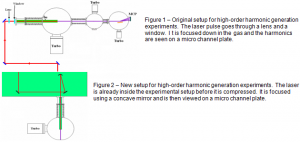Nathan Powers and Dr. Justin Peatross, Physics and Astronomy
Since the invention of lasers it has been possible to convert laser light into harmonics. This is a good way to achieve new shorter wavelengths of light. Unfortunately, all materials have a frequency-dependent refractive index that causes light of different frequencies to travel at different speeds. This means that the laser light which generates the harmonic waves travels at a different speed than the harmonics themselves. When this happens the waves can quickly get out of phase and the harmonics generated up stream cancel with those generated down stream. Good conversion in laser harmonic generation cannot be achieved in glass due to this phase mismatching. I investigated a technique to overcome this problem in glass known as quasi phase matching.
I used a series of finely spaced ultra-short counter-propagating laser pulses. These reverse-traveling pulses interfere with the forward going pulse to extinguish harmonic production in out-of-phase regions. Regions where harmonics are generated in-phase are not affected by these counter-propagating pulses so that the only harmonics produced are in phase with each other.
The coherence length for harmonic generation in glass is about 20 microns. I separated the counter-propagating pulses with a periodic spacing four times longer than this (an extra factor of two arising because colliding pulses approach each other at 2c as viewed in the laboratory) and was unable to observe any harmonics. We soon determined that this technique would not produce harmonics.
After finding that this experiment would not be successful, I began working on reducing intensity-dependent distortions of an ultra-short laser pulse for the high-order harmonic generation experiments that are carried out in Dr. Peatross’ lab. The generation of high-order harmonics is done by focusing an intense ultra-short laser pulse in helium. These harmonics have wavelengths in the extreme ultraviolet which are quickly absorbed by materials. Thus, after they are generated it is important that they travel through a vacuum. It is also important that the laser pulse which generates the harmonics be a Gaussian pulse. Getting an intense laser pulse into a vacuum can be troublesome due to intensity-dependent distortions.
When an intense laser pulse traverses a material the more intense parts of the pulse experience a greater index of refraction than the less intense parts of the pulse. Spatially, the center of a laser pulse is much more intense than the outsides of the pulse which causes the pulse to focus down inside the material. As it focuses down the intensities increase which causes the beam to focus down even further. Temporally, the middle of the pulse is more intense than the front and back of it which causes the middle of the pulse to get behind the rest of the pulse.
My project was to design and construct a setup which would allow us to get the intense ultra-short laser pulse focused down in the helium without traversing any material. The laser pulse is made into an intense ultra-short laser pulse using a diffraction grating which causes the different frequency components of the laser pulse to be compressed together. Previously, the pulse was intensified and then sent through a window to enter the vacuum. In the new setup we vacuum down the chamber which contains the gratings and then introduce helium into the chamber. This allows the pulse to enter the experimental area before it is compressed. The previous setup also used a lens to focus the beam down inside the helium. By instead using a concave mirror the distortions caused by the lens are avoided. A molybdenum foil is placed between the chamber containing the helium and the two subsequent vacuum chambers. The focused laser beam drills a hole through the molybdenum foil that allows the harmonics to enter the vacuum chamber and be viewed on a micro channel plate.
After building the new setup for the lab we spent several weeks doing careful alignments of the optics and were able to view high-order harmonic generation. I am now helping to automate the new setup and do experiments studying high-harmonic generation.
My work on these experiments has caused me to become very interested in continuing physics research. I hope to be able to learn much more as I finish working on this project and continue my schooling to get a doctorate in physics.

